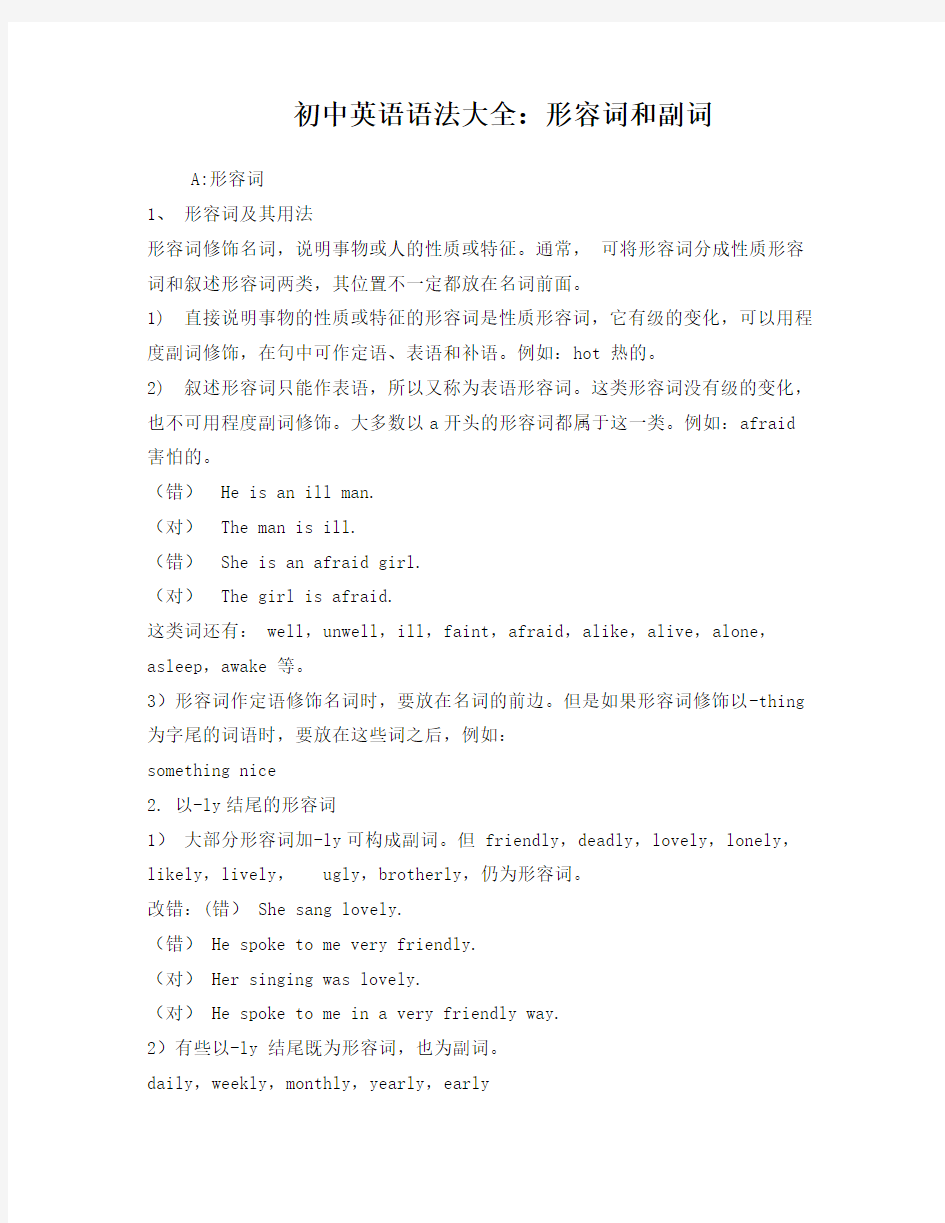

初中英语语法大全:形容词和副词
A:形容词
1、形容词及其用法
形容词修饰名词,说明事物或人的性质或特征。通常,可将形容词分成性质形容词和叙述形容词两类,其位置不一定都放在名词前面。
1) 直接说明事物的性质或特征的形容词是性质形容词,它有级的变化,可以用程度副词修饰,在句中可作定语、表语和补语。例如:hot 热的。
2) 叙述形容词只能作表语,所以又称为表语形容词。这类形容词没有级的变化,也不可用程度副词修饰。大多数以a开头的形容词都属于这一类。例如:afraid 害怕的。
(错)He is an ill man.
(对)The man is ill.
(错)She is an afraid girl.
(对)The girl is afraid.
这类词还有: well,unwell,ill,faint,afraid,alike,alive,alone,asleep,awake 等。
3)形容词作定语修饰名词时,要放在名词的前边。但是如果形容词修饰以-thing 为字尾的词语时,要放在这些词之后,例如:
something nice
2. 以-ly结尾的形容词
1)大部分形容词加-ly可构成副词。但 friendly,deadly,lovely,lonely,likely,lively, ugly,brotherly,仍为形容词。
改错:(错) She sang lovely.
(错) He spoke to me very friendly.
(对) Her singing was lovely.
(对) He spoke to me in a very friendly way.
2)有些以-ly 结尾既为形容词,也为副词。
daily,weekly,monthly,yearly,early
The Times is a daily paper.
The Times is published daily.
3 用形容词表示类别和整体
1)某些形容词加上定冠词可以泛指一类人,与谓语动词的复数连接。如:the dead,the living,the rich,the poor,the blind,the hungry
The poor are losing hope.
2)有关国家和民族的形容词加上定冠词指这个民族的整体,与动词的复数连用。the British,the English,the French,the Chinese.
The English have wonderful sense of humor.
4 多个形容词修饰名词的顺序
多个形容词修饰名词时,其顺序为:
限定词--数词--描绘词--(大小,长短,形状,新旧,颜色) --出处--材料性质,类别--名词
a small round table
a tall gray building
a dirty old brown shirt
a famous German medical school
an expensive Japanese sports car
典型例题:
1) Tony is going camping with ___ boys.
A. little two other
B. two little other
C. two other little
D. little other two
答案:C。由"限定词--数词--描绘词--(大小,长短,形状,新旧,颜色) --性质--名词"的公式可知数词,描绘词,性质依次顺序,只有C符合答案。
2) One day they crossed the ____bridge behind the palace.
A. old Chinese stone
B. Chinese old stone
C. old stone Chinese
D. Chinese stone old
答案A. 几个形容词修饰一个名词,他们的排列顺序是:年龄,形状,大小+颜色+
来源+质地+用途+国家+名词。
3) ---- How was your recent visit to Qingdao?
---- It was great. We visited some friends,and spent the ___days at the seaside.
A. few last sunny
B. last few sunny
C. last sunny few
D. few sunny last
答案:B。本题考查多个形容词的排序问题。一般与被修饰形容词关系密切的形容
词靠近名词;如果几个形容词的重要性差不多,音节少的形容词在前,音节多的方在后,在不能确定时,可参照下表:
限定词+数量词(序数词在前,基数词在后)+性状形容词+大小、长短、高低等形
体+
those + three + beautiful + large + square
新旧+颜色+国籍+材料+名词
old + brown + wood + table
5下列几类形容词也没有比较等级:
(1)表示“终极”意义或绝对概念的形容词或副词。如:absolute(ly), blind, dead, excellent, entire, living, full, perfect(ly), round, relative, wrong等。
(2)表示时间、方位或方向的形容词或副词。如:back, backward, forward, front, past, monthly, weekly, present, southern, vertical等。
(3)部分表示事物性质、物质材料或结构成分的形容词。如:atomic, cultural, economic, educational, golden, political, scientific, silken, urban, wooden等。
(4)本身具有“最”或“唯一”概念的形容词。如:maximal, mere, minimal, matchless, sole, only unique等。
6形容词作定语时的后置
a.前面我们讲到形容词作定语时,位置要放在所修饰的名词前面,但当它带有表示量度的词或词组时,定语后置。
They have built a bridge a hundred meters long.
他们建成了一座一百米长的桥。
Last year we built a building thirteen storeys high.
去年,我们盖了一栋十三层的高楼。
b.带有表示量度的词或词组,作表语时,也后置。
The bridge is a hundred meters long.
这座桥长达一百米。
The building is thirteen storeys high.
这个大楼有十三层高。
They have built a two-hundred-meter-long bridge.
他们已经修建了一座长二百米的桥。
注意
量度词组变成合成语时,作定语用,放在名词前。
Last year we built a thirteen-storey-high building.
去年我们建了一座高十三层的大楼。
c.另外,一些形容词或形容词词组常用来放在句首、句中或句尾,作状语。
He returned home, tired and hungry.
他又累又饿地回到了家。
Cold and hungry, he walked in the street.
又冷又饿,他走在街道上。
B: 副词及其基本用法
1 副词的种类、用法和位置
副词在句子中修饰动词、形容词、副词或整个句子。用来表示时间、场所、状态及程度。
1 副词的种类
1.副词的种类
(1)时间副词
①表示大体时间:now,then,yesterday,today,
tonight,before,justnow,recently,so far
②表示频率:always,usually,often,sometimes.seldom,never
③其它作用:already,yet,late,early,soon,at
once,immediately,atfirst,at last,finally
(2)地点副词
①表地点:
here,there,home,abroad,upstairs,downstairs,anywhere,everywhere,
nowhere,somewhere.
②表位置关系(后接宾语时,用作介词):
above,below,round,around,down,up,in,out,inside,outside,across,back, along,over,
away,near,off,past
(3)方式副词表示谓语动词"怎样地",(此类副词大部分由形容词加ly构成):
badly,bravely,gratefully,calmly,carefully,carelessly,nervously,prou dly,patiently,
politely,sadly,properly,rapidly,
wrongly,suddenly.
(4)程度副词多数用来修饰形容词或副词:much,(a)little,a
bit,very,sO,too,enough,quite,rather,completely,terribly,deeply,nearly,al most,hardly
(5)疑问副词构成特殊疑问句:how,when, where,why
(6)连接副词连接主语、宾语或表语从句:how,when,where,why
(7)关系副词引导定语从句:when,where,why
(8)其它性质的副词对整个句子进行说明,一般用逗号与主句隔开:
frankly(坦率地说,说真的),generally(一般说来),luckily(幸运地是),first of all(首先)等。
1.地点副词、时间副词和方式副词一般放在句末
注意
地点副词作定语时要后置,不属于这种情况。有时少数地点副词和时间副词可以作定语,放在所修饰词的后边。
The students here are all from China.
I'll wait for you here.(地点副词)
我将在这儿等你。
I'll meet him at the station tomorrow.(时间副词)
明天我将去车站接他。
Tomorrow I'll meet him at the station.
注意
有时为了强调时间,也可把时间副词放在句首。
The boy wrote the homework quickly.
(方式副词)
这个男孩子写作业很快。
They did their experiments carefully in the labyesterday.方式地点时间
昨天他们在实验室认真地做实验。
The students all worked well here last week
这些学生上周在这里都做得很好。
2.频度副词在句中位置有以下两种
a.在be动词、情态动词及第一个助动词之后。
She is always kind to us(be动词)
她对我们总是很好。
I can never forget the day.(情态动词)
我永远也不能忘掉这一天。
The work has never been done.
助动词助动词
(频度副词never放在第一个助动词has的后面)
这件工作永远也做不完。
b.在实义动词之前
He often goes to school early.(实义动词)
他常常早到校。
3.程度副词有下列二种情况
a.修饰动词时,它在句中的位置与频度副词的情况相似。
He is almost forty years old.(在be动词之后)
他快四十岁了。
注意
如果句末同时有几个副词,它的基本顺序是:方式副词+地点副词+时间副词。
He can hardly understand you.
(在情态动词之后)
他几乎听不懂你的活。
I like the boy.(在实义动词之前)
我相当喜欢这个男孩子。
b.修饰形容词、副词时,放在它所修饰的词的前面。
He studies much harder now.
现在他学习努力多了。
The room is big enough to hold fifty persons.
(enough修饰形容词)
这个房间够大的可以容纳50人。
He runs fast enough.(enough修饰副词)
他跑得够快的。
注意:副词very 可以修饰形容词,但不能修饰动词。
改错:(错) I very like English.
(对) I like English very much.
注意:副词enough要放在形容词的后面,形容词enough放在名词前后都可。
I don't know him well enough.
There is enough food for everyone to eat.
There is food enough for everyone to eat.